Table Of Contents

Yerukola Eswara Prasad

Akshata Tiwarkhede
Transmission Lines - Shedding Light on the Future with Connected Infrastructure

Peering into the Past & Present Landscape of Transmission Lines
Constant technological advancements in transmission lines have played a significant role in enhancing the capacity and efficiency of modern electrical power systems. 1882 marked the history of transmission lines with the launch of first commercial power station, Pearl Street Station in New York City. Although power supply was successful with the use of direct current over short distances, transmission faced significant limitations over longer distances as well as in terms of power loss. However, the advent of alternating current enabled the efficient transmission of power supply over long distances. For instance, Niagara Falls Project marked a milestone with the use of alternating current to transmit power over 20 miles to Buffalo, New York.
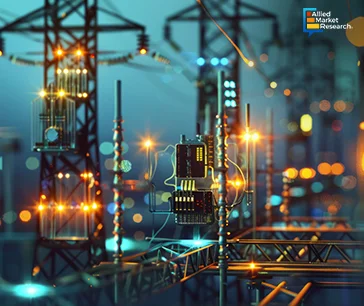
Numerous technological advancements were witnessed in the twentieth century such as the introduction of insulated cables and underground transmission lines to overcome the challenge of deploying overhead transmission lines in urban areas. High-voltage direct current technology was developed in the mid-twentieth century, which were used in long underwater cables and asynchronous grids. The advent of smart grid technologies and real-time monitoring systems has enhanced the efficiency and reliability of power transmission networks. As the demand for electricity is expected to grow substantially, the evolution of the industry is likely to continue with ongoing developments such as ultra-high-voltage transmission systems and flexible alternating current transmission systems.
Brazil Houses the World’s Longest Power Transmission Lines
World’s largest power transmission lines are deployed in Brazil, followed by China and India. Belo Monte-Rio de Janeiro is a 2,543km-long transmission line that transmits electricity from 11.2GW Belo Monte hydroelectric power plant located in Para to Rio de Janeiro, Brazil. The construction of this 800kV ultra-high-voltage direct current line commenced in September 2017 and was completed in April 2019. The 2,385 km-long Rio Madeira transmission link transmits electricity from the Santo Antônio and Jirau hydropower plants on the banks of the Madeira River in north-west Brazil. This 600kV high-voltage direct current bipolar line exhibits the capacity to transmit 7.1GW of power. The transmission of electricity from the Belo Monte hydroelectric power station in northern Brazil to southeast Brazil is facilitated with the help of 2,092km-long, 800kV ultra-high-voltage direct current Belo Monte-Estreito transmission line. These systems significantly enhance the country's ability to distribute electricity from remote hydroelectric plants to urban and industrial centers, ensuring a stable and reliable energy supply. In addition, this infrastructure will help to support economic growth, reduce energy losses over long distances, and contribute to the integration of renewable energy sources into the national grid.
Exponential Rise in Electricity Needs
The global economy is increasing its dependency on electricity. Increasing environmental awareness related to greenhouse gas emissions from different end-use sectors is one of the primary reasons for the shift toward clean electricity. In addition, with technological advancements in the green energy sectors, such as solar, wind, and hydro, the demand for renewable energy is creating in-roads in many application areas. For instance, in the automotive industry, electric vehicles are witnessing higher penetration as compared to internal combustion engines vehicles. In 2023, nearly 14 million electric vehicles were sold, showcasing an increase of 33% as compared to 10.5 million sales in 2022. With such a huge electric vehicle presence, establishing sufficient and efficient charging infrastructure also needs to be focused on. Hence, for the charging of these electric vehicles, a huge amount of electricity will be required from the electric supply grid. To reduce excessive electric load on the existing power grid, new transmission lines projects are being taken up to meet the growing electricity demand.
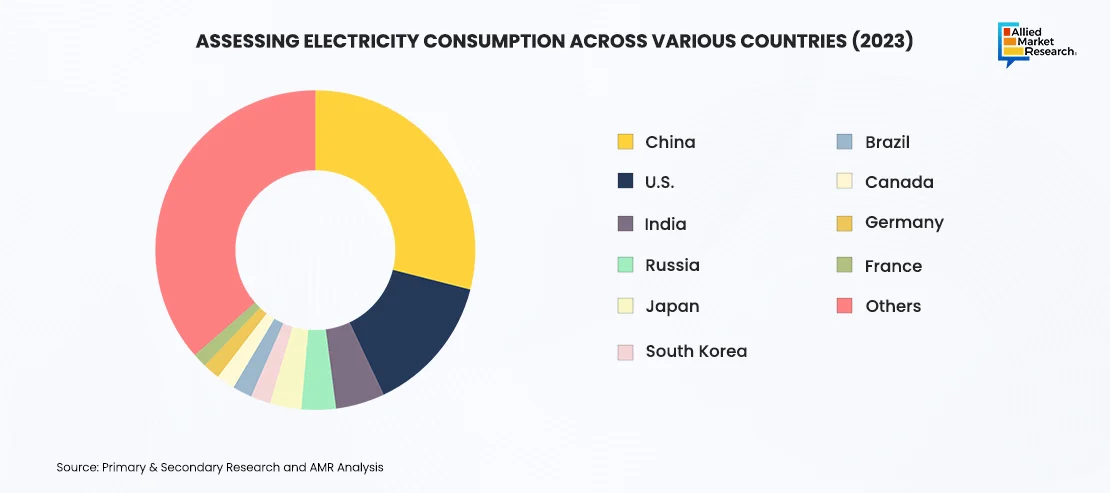
Assessing Electricity Consumption across Various Countries (2023)
The above figure depicts that China, the U.S., and India accounted for more than 48% of the electricity consumed in 2023, as they are industrialized economies and are the major manufacturing hubs globally. Also, China and India have a large population base, serving various commercial application sectors. Due to these factors, almost 50% of the global electricity demand is in these three countries. Furthermore, with technological advancements and increasing consumer purchasing power parity, the automotive industry is anticipated to witness notable growth in these economies. Charging electric vehicles requires electricity, which is provided through national transmission grid lines for use. To meet this additional electricity demand, new transmission projects can be announced or existing transmission lines can be upgraded to handle extra-large electric voltage. To cater to all these requirements, electric vehicle manufacturers can provide updated vehicle models, while electricity grid corporations supply the necessary electricity through different transmission lines.
For instance, BYD Company Ltd. (China), one of the largest electric vehicle manufacturers globally, sold 721,328 units in 2021, 1,802,464 units in 2022, and 3,024,417 units in 2023, globally. The company has a global presence with a major sales volume focused on China itself. With such a high sales volume, the electricity required for charging them will also increase rapidly.
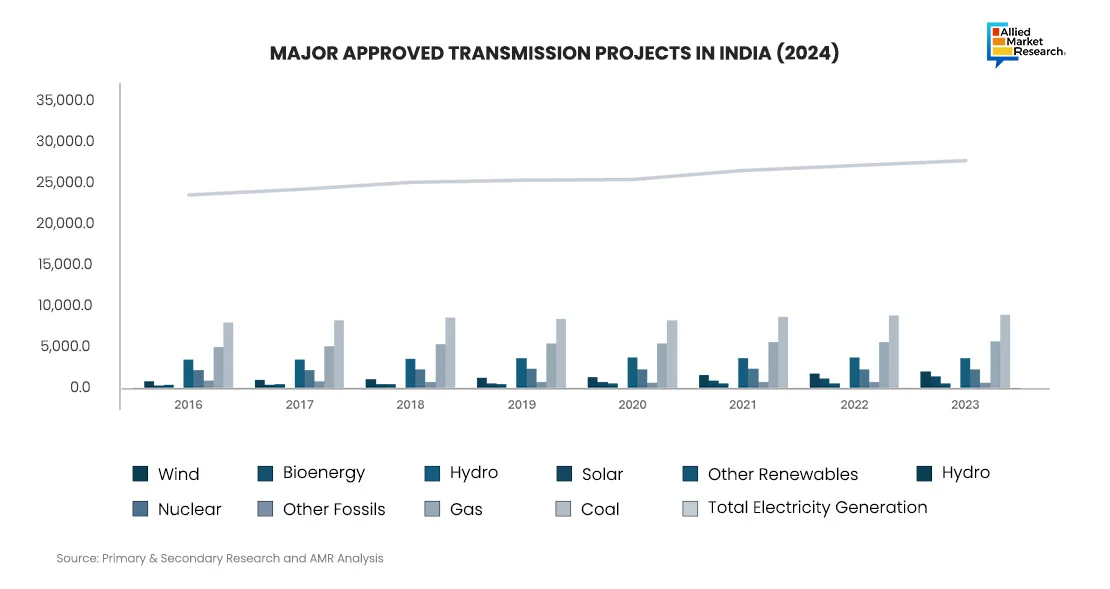
As seen from the above figures, the electricity production in 2018 was around 24,662.8 TWh and increased to 29,480.7 TWh in 2023. Electricity generation between 2016 and 2023 showed a growth of more than 3%. Coal- and gas-based electricity accounted for the largest production share, followed by renewable energy generation in 2023. Therefore, with increasing electricity needs, new transmission lines can be set or existing network can be upgraded.
Lightning the Future by Navigating Challenges
Clean energy generated needs to be transferred through the power grid to reach the end users. For the construction of new transmission lines, utility companies, landowners, and regulators need to be on the same page. There are instances where landowners and other general population outright protest these projects due to various reasons. For instance, in Maine (U.S.), the residents have protested against a power line extension, known as New England Clean Energy Connect, for delivering 1,200 megawatts of renewable hydroelectric power from Canada to Massachusetts. The residents allege that the project will harm the local biodiversity. Due to such gridlocks, clean energy generation cannot be distributed to end users. Sandi Howard, an 8th generation Mainer who is a professor of music at Keene State College and has led commercial whitewater and outdoor adventures for 26 years, reported to CNBC that “Mainers want to protect its environment and way of life. If the power line were to be constructed, there would be a dramatic impact to Maine’s natural resources, scenic character, economic impact to Maine’s four-season recreational tourism industry.”
To mitigate this issue, certain proposals can be taken into consideration. The existing power grid can be upgraded (reconstructing old transmission lines with new ones) for capacity expansion along with new material usage in transmission lines. Also, new power grids can be constructed along highways where land acquisition will not be an issue. Such approaches can be undertaken by utility companies for expanding transmission lines.
Focusing on New Electricity Grid Projects
Transmission lines serve as the most efficient systems for transferring electricity from the generation site to end users. To meet the growing electricity demand, new transmission line projects are being announced or existing transmission circuits can be upgraded to handle large electric voltage. Below are some of the major projects in the U.S. and India.
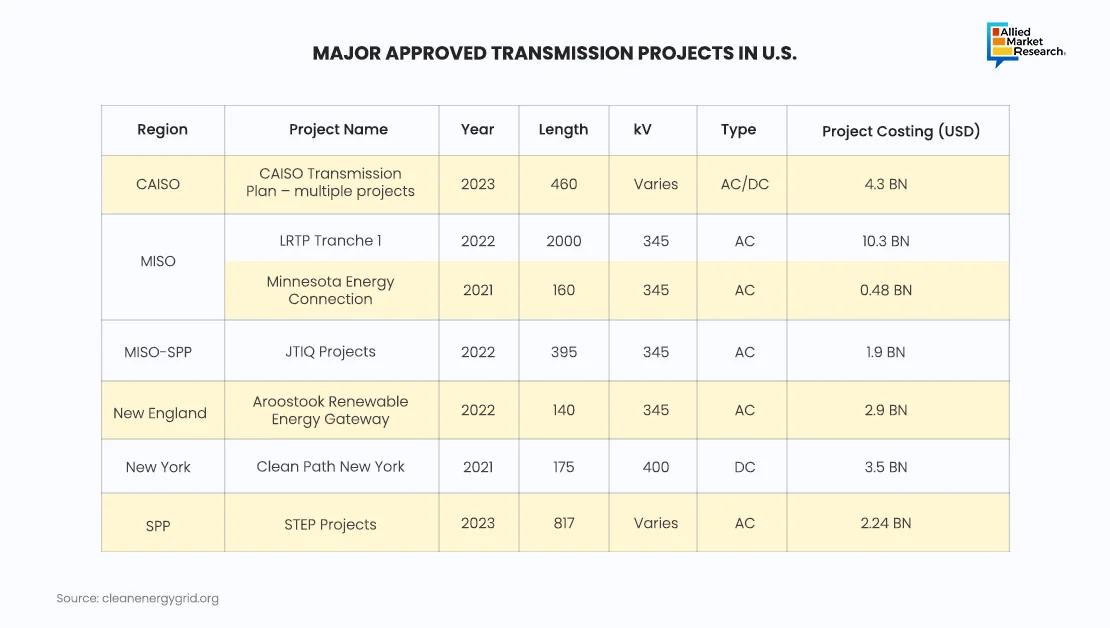
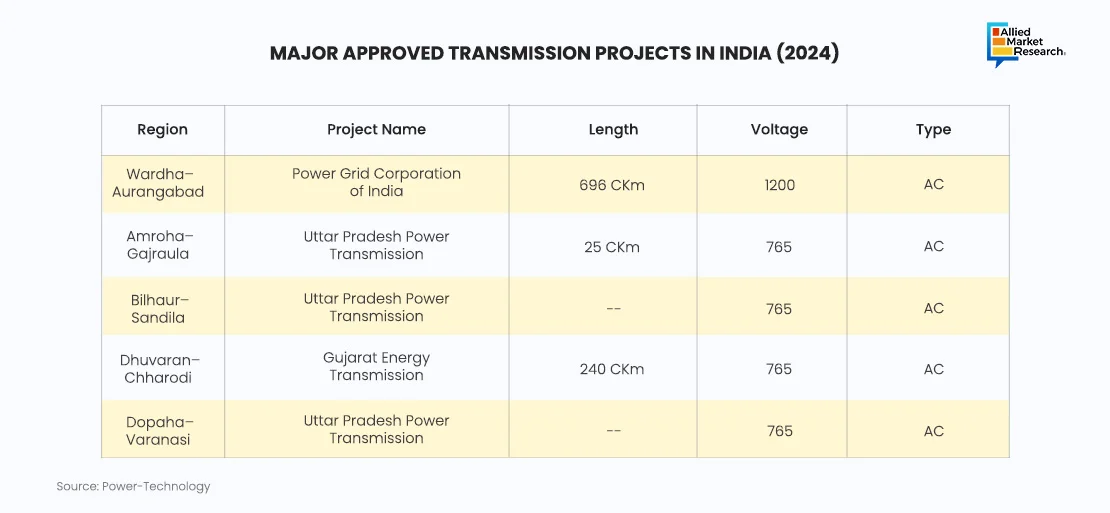
The table above showcases some noteworthy projects in the U.S. and India. These transmission lines have long circuit routes along with high-voltage electric currents. Announcement of new transmission project implies the growing need for electricity, for use in the residential, commercial, and industrial sectors. India and the U.S. are the major manufacturing-based economies and hence must be self-reliant on electricity production. Also, with increasing impetus being provided to renewable energy generation, clean electricity will have a better turnover time as compared to conventionally generated electricity. Hence, for the consumption of clean and uninterrupted electricity, a large transmission grid is necessary.
To Sump Up
To improve the capacity and efficiency of modern electrical power systems, constant technological advancements have been witnessed in transmission lines, which are indicative of the industry’s evolving dynamics. New transmission lines are being deployed and existing network are being upgraded to meet the increasing electricity needs in the industrialized economies such as China, India, and the U.S., which are known as the major manufacturing hubs across the globe. These efforts are essential for maintaining the reliability and sustainability of power supplies in these key economies. As China, India, and the U.S. continue to upgrade their electrical infrastructure, they set a benchmark for global energy practices, emphasizing the critical role of advanced transmission technologies in supporting industrial growth and economic stability.
For further insights, get in touch with AMR analysts.

